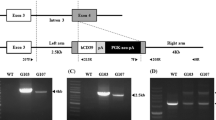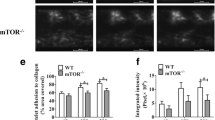Abstract
Peptides containing Arg-Gly-Asp (RGD) have been used to decrease thrombosis by competitive inhibition of the integrin glycoprotein, αIIb/β3a, in platelets. However, they have a short half-life in vivo. A naked plasmid, pCMV-RGD, was transferred into the skeletal muscle of mice and RGD gene expression was observed by RT-PCR. The bleeding time between control mice and RGD-transferred mice was prolonged from the 10th day to the 80th day after gene transfer while the blood glucose and serum insulin-like proteins remained at normal levels. These results provided a convenient and effective approach to relieve patients from thrombi in a single step over a relatively long period.
Similar content being viewed by others
References
Cappelletti M, Zampaglione I, Rizzuto G, Ciliberto G, La Monica N, Fattori E (2003) Gene electro-transfer improves transduction by modifying the fate of intramuscular DNA. J. Gene Med. 5: 324–332.
Dejana E, Villa S, de Gaetano G (1982) Bleeding time in rats: a comparison of different experimental conditions. Thromb. Haemost. 48: 108–111.
Del Vecchio A (2002) Use of the bleeding time in the neonatal intensive care unit. Acta. Paediatr. Suppl. 91: 82–86.
Glorioso JC, Huang L, Dunbar C, Felgner PL (2000) Highlights from the third annual ASGT meeting. American Society of Gene Therapy. Mol. Ther. 2: 96–100.
Hynes RO (1987) Integrins: a family of cell surface receptors. Cell 48: 549–554.
Liu B, Tang J, Ji J, Gu J (2003) Prevention of osteoporosis in ovariectomized mice by electroporational gene transfer of para-thyroid hormone. Biotechnol. Lett. 25: 2117–2122.
Liu J, Yang X, Chen W, Tang J (2002) Effect of disulfide bond on the conformation and anticoagulant activity of an Arg-Gly-Asp mo-tif displayed on a mutant insulin protein framework. Lett. Pept. Sci. 9: 179–186.
Mir LM, Bureau MF, Gehl J, Rangara R, Rouy D, Caillaud JM, Delaere P, Branellec D, Schwartz B, Scherman D (1999) High-efficiency gene transfer into skeletal muscle mediated by electric pulses. Proc. Natl. Acad. Sci. USA 96: 4262–4267.
Muramatsu T, Mizutani Y, Ohmori Y, Okumura J (1997) Comparison of three nonviral transfection methods for foreign gene expression in early chicken embryos in ovo. Biochem. Biophys. Res. Commun. 230: 376–380.
Ragot T, Stratford-Perricaudet LD, Vincent N, Chafey P, Vigne E, Gilgenkrantz H, Couton D, Briand P, Kaplan JC, Kahn A et al. (1994) Adenovirus-mediated transfer of a human dystrophin gene to skeletal muscle of mdx mouse. Gene Ther. Suppl. 1: S53–S54.
Robbins PD, Ghivizzani SC (1998) Viral vectors for gene therapy. Pharmacol. Ther. 80: 35–47.
Ruoslahti E, Pierschbacher MD (1987) New perspectives in cell adhesion: RGD and integrins. Science 238: 491–497.
Titomirov AV, Sukharev S, Kistanova E (1991) In vivo electroporation and stable transformation of skin cells of newborn mice by plasmid DNA. Biochim. Biophys. Acta 1088: 131–134.
Torchilin VP, Lukyanov AN (2003) Peptide and protein drug delivery to and into tumors: challenges and solutions. Drug Discov. Today 8: 259–266
Torn M, van der Meer FJ, Rosendaal FR (2004) Lowering the intensity of oral anticoagulant therapy: effects on the risk of hemorrhage and thromboembolism. Arch. Intern. Med. 164: 668–673.
Wang XD, Liu J, Yang JC, Chen WQ, Tang JG (2003) Mice body weight gain is prevented after naked human leptin cDNA transfer into skeletal muscle by electroporation. J. Gene Med. 5: 966–976.
Wilhite DB, Comerota AJ, Schmieder FA, Throm RC, Gaughan JP, Rao AK (2003) Managing PAD with multiple platelet inhibitors: the effect of combination therapy on bleeding time. J. Vasc. Surg. 38: 710–713.
Yang J, Liu J, Yang X, Tang J (2002) Gene therapy for diabetic rats by electroporational transfer of naked plasmid with human pre-pro-insulin gene into skeletal muscle. Biotechnol. Lett. 24: 851–855.
Yin D, Tang JG (2001) Gene therapy for streptozotocin-induced diabetic mice by electroporational transfer of naked human insulin precursor DNA into skeletal muscle in vivo. FEBS Lett. 495: 16–20.
Author information
Authors and Affiliations
Rights and permissions
About this article
Cite this article
Chen, W., Liu, J., Diao, W. et al. Transfer of a gene containing the Arg-Gly-Asp peptide prolongs the bleeding time of mice. Biotechnology Letters 26, 1575–1580 (2004). https://doi.org/10.1023/B:BILE.0000045655.04327.8f
Issue Date:
DOI: https://doi.org/10.1023/B:BILE.0000045655.04327.8f




